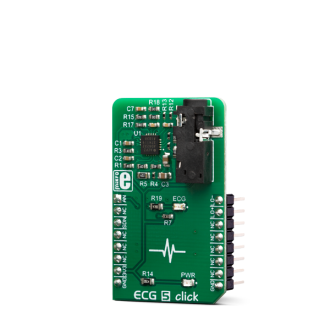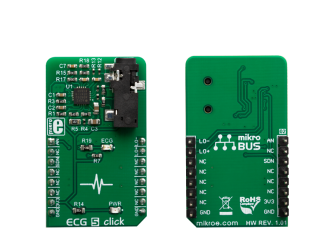
We strongly encourage users to use Package manager for sharing their code on Libstock website, because it boosts your efficiency and leaves the end user with no room for error. [more info]

Rating:
Author: MIKROE
Last Updated: 2019-04-22
Package Version: 1.0.0.0
mikroSDK Library: 1.0.0.0
Category: Biometrics
Downloaded: 4661 times
Not followed.
License: MIT license
ECG 5 click can be used for the development of ECG and Heart-Rate (HR) applications. The Click board features the AD8232, an integrated bio-signal front end.
Do you want to subscribe in order to receive notifications regarding "ECG 5 click" changes.
Do you want to unsubscribe in order to stop receiving notifications regarding "ECG 5 click" changes.
Do you want to report abuse regarding "ECG 5 click".


Library Description
The library performs a device mode setting (Normal or Shutdown) and a leads off detection checking. Also the library initializes GPIO driver. For more details check documentation.
Key functions:
void ecg5_setMode( uint8_t state ) - Function performs a device mode setting.T_ECG5_RETVAL ecg5_check_LOD_negative( void ) - In DC Leads Off Detection Mode, LOD- is high when the electrode to -IN is disconnected, and it is low when connected. In AC Leads Off Detection Mode, LOD- is always low.void ecg5_gpioDriverInit(T_ECG5_P gpioObj) - Function initializes GPIO driver.Examples description
The application is composed of the three sections :
void applicationTask()
{
if (respReady == RESPONSE_READY)
{
respReady = RESPONSE_NOT_READY;
adcValue = ADC_Get_Sample( 0 );
WordToStr( adcValue, text );
mikrobus_logWrite( text, _LOG_TEXT );
mikrobus_logWrite( ",", _LOG_TEXT );
LongWordToStr( plotX, text );
mikrobus_logWrite( text, _LOG_LINE );
if (plotX == 0xFFFFFFFF)
{
plotX = 0;
}
else
{
plotX++;
}
}
}
Other mikroE Libraries used in the example:
ADCUARTConversionsAdditional notes and informations
Depending on the development board you are using, you may need USB UART click, USB UART 2 click or RS232 click to connect to your PC, for development systems with no UART to USB interface available on the board. The terminal available in all MikroElektronika compilers, or any other terminal application of your choice, can be used to read the message.